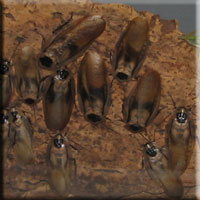 |
|||||
| How cockroaches keep their predators 'guessing' | |||||
Nov 13, 2008
When cockroaches flee their predators, they choose, seemingly at random, amongst one of a handful of preferred escape routes, according to a report published on November 13th in Current Biology, a Cell Press publication. "By using one of a number of possible trajectories, we think that cockroaches may behave with sufficient unpredictability to avoid the possibility that predators will learn their escape strategy," said Paolo Domenici of CNR-IAMC in Italy. "As we say in our report, the predator is made to guess." Cockroaches have been studied for many years as a model for understanding animal escape responses, he said. While much is known about the neural circuitry underlying their behavior, it still seemed to Domenici's team that open questions remained regarding their strategy. While the insects don't run away in random directions, they nonetheless didn't seem to flee in an easily predictable manner either. In the new study, the researchers searched for some pattern by repeatedly testing cockroaches as they escaped from threats. What they found is that cockroaches select one of a number of preferred trajectories. Their choice is not completely random because the angle at which the bugs are stimulated to run seems to limit the options. However, when they are startled from certain directions—head on, for example—cockroaches flee along four primary escape routes at fixed angles from the threat. The researchers aren't yet sure exactly how the cockroaches manage this at the neural level, but they suspect they aren't the only animals that do so. The findings also raise questions about the evolutionary forces that drive such unpredictable anti-predator behavior. More broadly, the results show that "unpredictable" behavioral patterns in nature can actually be quite structured, Domenici said. Animals that may seem to be carrying out a single behavior pattern with wide variation could instead be choosing between multiple strategies. As for those of us who might occasionally want to kill a roach or two ourselves, Domenici says the insects most often choose an escape path directed at a 90 to 180 degree angle from the attack. "This is where squashing could be aimed," he said, "although we like cockroaches and would recommend no squashing." Adapted from materials provided by Cell Press via EurekAlert!, a service of AAAS |
|||||
